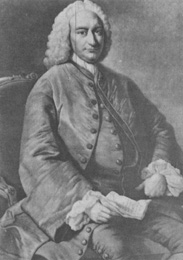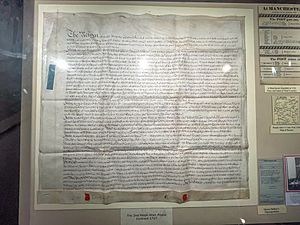Ralph Allen facts for kids
Quick facts for kids
Ralph Allen
|
|
|---|---|
 |
|
| Born | 1693 |
| Died | 29 June 1764 |
| Resting place | Claverton Churchyard |
| Nationality | British |
| Occupation | Postmaster |
| Known for | Quarrying of Bath Stone |
Ralph Allen (born 1693, died 1764) was a clever British businessman and a kind person who helped others. He is famous for making big improvements to England's mail system.
He was born in Cornwall but moved to Bath to work at the post office. By the time he was 19, he became the postmaster there. He made the mail system much better and faster. He even took over contracts for sending mail across England, all the way to Scotland and into South Wales.
With the money he earned from the postal system, he bought local stone mines. He built his grand house, Prior Park, to show off how amazing the local Bath stone was. He also used his old post office building as his town house. Working with the architect John Wood the Elder, the stone from his mines was used to build many beautiful Georgian buildings in Bath. Even though the mines didn't always make money, Allen used his postal profits to keep them going.
After he died, Ralph Allen was buried in a special pyramid-shaped tomb in Claverton churchyard. Many streets and schools in Bath are named after him. He was also the inspiration for a character named Squire Allworthy in the famous book Tom Jones by Henry Fielding.
Contents
Ralph Allen's Early Life
We don't know much about Ralph Allen's very early life. The Oxford Dictionary of National Biography says his father was Philip Allen, who was thought to be an innkeeper. As a teenager, Allen worked at the Post Office in St Columb Major. His grandmother ran that post office.
In 1710, he moved to Bath. There, he became a clerk at the post office. By 1712, when he was just 19 years old, he became the Postmaster of Bath. Later, in 1742, he was chosen to be the Mayor of Bath.
Improving the Postal System

When Ralph Allen was 27, he took charge of the "Cross and Bye Posts" in the South West of England. This was part of the mail system. He had a seven-year contract with the General Post Office, even though he didn't have an official title. At first, he didn't make any profit, just breaking even. But he was brave and decided to keep going.
Over the next few years, he completely changed the postal service. He noticed that mail carriers were delivering letters along their routes without telling anyone. This meant the Post Office was losing money. To stop this, he started a "signed for" system. This made sure every letter was accounted for. He also made the system faster by allowing mail to go directly between towns, instead of everything having to pass through London first.
Ralph Allen became very well-known for his work. He took over more and more of the English postal system. He signed new contracts every seven years until he died at age 71. It's believed that he saved the Post Office a huge amount of money, about £1,500,000, over 40 years. He also gained the support of General Wade in 1715. This happened when Allen shared important information about a Jacobite uprising in Cornwall.
Bath Stone and His Homes
When John Wood arrived in Bath, Ralph Allen used his wealth from postal reforms to buy stone quarries. These were located at Combe Down and Bathampton Down Mines. Before Allen, the stone workers often cut stone roughly. This meant the blocks were different sizes and had uneven surfaces. This rough stone is called "rubble." You can still see buildings made with this type of stone in older parts of Bath.
The special honey-coloured Bath stone became very popular. It was used to build the beautiful Georgian city of Bath. This stone helped Allen make a second fortune. The building he used as a post office in Lilliput Alley (now North Parade Passage) became his town house. In 1727, he updated the front of the house, made it bigger, and added another floor. John Wood the Elder wrote about this in his book. Allen was very good at showing off the quality of Bath stone. He even built a fancy building near his house just to display how good the stone was. This part of the house is now known as "Ralph Allen's Town House." Allen lived there until 1745, when he moved to Prior Park. His town house then became his offices.
Allen had the grand Palladian mansion of Prior Park built in 1742. It sits on a hill looking over the city. He once said he built it "To see all Bath, and for all Bath to see." He also gave money and stone for the Mineral Water Hospital in central Bath, which was built in 1738. In 1758, he bought Claverton Manor, just east of Bath.
Ralph Allen also had a summer home built in the coastal town of Weymouth in Dorset. It was at 2 Trinity Street, looking over the harbour. There is a plaque on the house to remember him. His Bath stone was also used in the Georgian buildings of Weymouth.
Remembering Ralph Allen
Ralph Allen is buried in a tomb with a pyramid top in Claverton churchyard, near Bath. There was a marble statue of him in the Mineral Water Hospital. This statue was moved to the hospital's new building in 2019.
His name is remembered in Ralph Allen Drive. This road goes past his old home at Prior Park. It's now a busy road from Combe Down village to Bath city centre. This was once the path where stone from his quarries at Combe Down was sent down to the River Avon on wooden sledges. Prior Park College, a private school for students aged 11 to 18, is located in Allen's former home. One of its boarding houses for boys is named Allen House. The Prior Park Landscape Garden and its famous Palladian bridge are looked after by the National Trust. They restored the garden from ruin in 1993. He is also remembered by Ralph Allen School, which is one of the city's state secondary schools.
The Ralph Allen CornerStone in Combe Down village opened in the autumn of 2013. This building holds the records of the Combe Down Heritage Society. It also serves as a community center and information point. This was part of a project to fill in the old stone mines under the village.
Henry Fielding used Ralph Allen as the inspiration for the character of Squire Allworthy in his famous novel Tom Jones.
See also
 In Spanish: Ralph Allen para niños
In Spanish: Ralph Allen para niños


